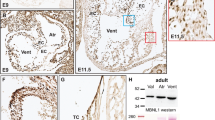Abstract
Endoglin is a component of the receptor complex for transforming growth factor (TGF)-β1 and TGF-β3. We analysed its expression by immunohistochemistry in human embryos at 4–8 weeks of gestation and in hearts ranging from 4–13 weeks old. We compared endoglin distribution with that of TGF-β receptors type I (TβR-I), type II (TβR-II) and betaglycan. Endoglin was found on endothelial cells in all tissues examined, consistent with its expression in adult blood vessels. TβR-I, TβR-II and betaglycan were observed on most cell types and had an overall similar pattern of distribution. Endoglin was detected on the endocardium as early as 4 weeks, but was absent from myocardium. It was present at high levels on the endocardial cushion tissue mesenchyme from 5–8 weeks’ gestation, during heart septation and valve formation, and subsequently decreased as the valves matured. Endoglin expression in heart extracts was confirmed by Western blot analysis. TβR-I, TβR-II and betaglycan were mostly found on cardiac myocytes, but were detectable at low levels on endocardium. They were expressed transiently on cushion mesenchyme, albeit at much lower levels than endoglin. All four components of the TGF-β receptor complex were detected by RT-PCR in embryonic heart. Thus transient up-regulation of the components of the TGF-β receptor complex, and particulartly of endoglin, is associated with heart septation and valve formation during early human development.
Similar content being viewed by others
Author information
Authors and Affiliations
Additional information
Received: 15 September 1997 / Accepted: 1 December 1997
Rights and permissions
About this article
Cite this article
Qu, R., Silver, M. & Letarte, M. Distribution of endoglin in early human development reveals high levels on endocardial cushion tissue mesenchyme during valve formation. Cell Tissue Res 292, 333–343 (1998). https://doi.org/10.1007/s004410051064
Issue Date:
DOI: https://doi.org/10.1007/s004410051064




